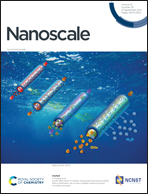Phosphorus-decorated Mo-MXene/CQD hybrid: a 2D/0D architecture for bifunctional electrochemical water splitting †
Abstract
The exploration of nonprecious metal-based 2D bifunctional electrocatalysts is of great significance for transforming to sustainable energies in terms of hydrogen. However, to achieve commendable electrocatalytic performance via rational design of surface-interface-engineered Mo-MXene hybrids remain challenging and highly demanding. Herein, we report large size exfoliated Mo-MXene sheets, which provide a flat flexible interface for decoration with carbon quantum dots (CQDs) and controlled surface phosphorization (denoted as Mo-MX/C/P hybrid). The resulting Mo-MX/C/P hybrid exhibited the lowest onset potentials of 14 and 58 mV at an applied current of 0.2 mA cm−2 for the HER and OER, respectively. Strikingly, the electronegative nature of phosphorous (P) and quick charge transfer between the CQDs and Mo2CTx matrix were responsible for its superior catalytic activities. Despite the superior performance, the Mo-MX/C/P hybrid can also be used for full-cell division of water with a cell voltage of 1.34 volts at 10 mA cm−2 and was found to be durable up to 12. This work provides a novel insight into the further development of surface-interface-engineered Mo-MXene hybrids for sustainable energy.



 Please wait while we load your content...
Please wait while we load your content...